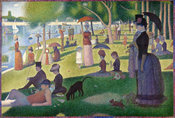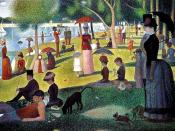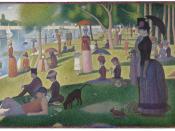CONFUCIUS, GANDHI AND THE
AESTHETICS OF VIRTUE
I think that in trying to find out whether moral goodness and beauty are in fact always linked, you are trying to answer an unanswerable question. We all have our own opinion on whether moral goodness and beauty are associated together. This is just mine.
Personally I don't agree with the fact of moral goodness and beauty being associated together. The way I see it is that when a person is (morally) good they are not always beautiful (outwardly); but on the inside they may be very pretty. And the same the other way around, a person could be very beautiful (outwardly), yet they act very ugly showing that inside they are immoral or devious.
I compare this to Georges Seurats painting "A Sunday Afternoon on the Island of La Grande Jatte". From a distance you see this unique painting of people enjoying an ideal day in the park.
There are children playing and couples courting, the men bragging, and the women talking. Everything seems like it is perfect. But the closer you get to this very unique picture you see how "dysfunctional" it is. You find it hard to tell one person from the next, everything seems to blur together. It leaves you very confused, and wondering what the picture is really like, or what it really means. This all ties into the beauty and goodness theory by the fact that you look at the picture from a distance and you see a beautiful picture just like looking at a person and seeing there outward beauty, but when you step in for a closer look you see how cluttered the picture is or how immoral that person is.
I think Gandhi said it best when he said?
Moral beauty is...


